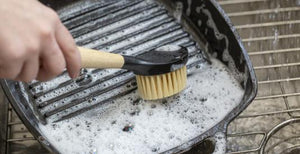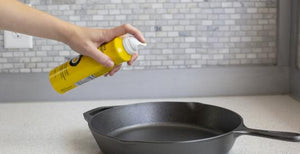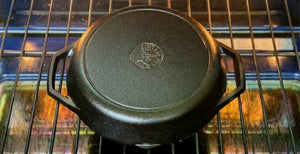
Cast Iron Seasoning
Cast Iron Seasoning
Find out what it is, why it's important and how to preserve your favorite Lodge cast iron cookware for decades of cooking.
Find out what it is, why it's important and how to preserve your favorite Lodge cast iron cookware for decades of cooking.

Seasoning is a layer of oil on the cast iron pan.
Seasoning is the process in which the cast iron cookware is baked with vegetable oil, obtaining a 100% natural non-stick finish, unlike most cookware on the market that has an artificial non-stick finish that wears easily and can become harmful to health , seasoned cast iron cookware is the healthiest choice. The more often you use a seasoned cast iron utensil, the more you strengthen its seasoning, while if you follow the correct instructions for cleaning and caring for it, it will last for generations. Lodge applies the seasoning process to all its cast iron cookware, using only soybean oil.

Lodge cast iron is ready to use.
Each Lodge utensil is seasoned and ready to use, as soon as you take it out of the box. The easiest way to maintain the seasoning layer is to use your cast iron pan as often as possible. Every time you poach an egg, grill a steak or a pie, you're adding layers of cooking fat and oil that enhance your seasoning for a natural, non-stick finish that improves over time.
How to season your Lodge Cast Iron pan.
There are two ways to preserve seasoning in your cast iron skillet. The easiest way is to cook with it. Every time you cook with oil, you potentially add another layer of seasoning.
Certain types of cooking can remove some seasoning, such as cooking acidic foods, excessive heat, or rubbing with abrasive utensils or metal sponges. cleaning. That's why our simple cleaning steps help your cast iron cookware to remain quality for every cooking.
You can also season your cast iron cookware in the oven. This method adds a more complete layer of armor to the entire pan, enhancing the seasoning with the cast iron. It can be beneficial to season your cast iron ovenware a few times a year. We recommend seasoning in the oven when restoring a rusted cast iron cookware.

Step 1: Scrape your pan
Wipe the pan with warm, soapy water. It's okay to use soap if you're going to re-season cookware. Rinse and dry well by hand.

Step 2: Oil
Apply a very thin, even layer of cooking oil to the pan (inside and out). If you use too much oil, your cookware may become sticky.

Step 3: Bake for 1 hour
Place the dish upside down in the oven. Place a large baking sheet or aluminum foil on the lower rack. Bake at 450-500 degrees F for one hour. Let it cool.

What oils can I use in seasoning?
All cooking oils and fats can be used for seasoning, but based on availability, affordability, effectiveness and having a high smoke point, Lodge recommends vegetable oil, rendered fat or canola oil, such as our spray for seasoning.
What oil does Lodge use to season their cookware?
Lodge began seasoning cast iron cookware in our foundries in 2002. In the final step before packaging, we spray a thin layer of soy-based vegetable oil onto traditional cast iron and carbon steel cookware and then bake in a large oven. No synthetic chemicals are added. The oil is highly refined and all allergy-causing proteins associated with soy are eliminated. The oil is kosher and does not contain animal fat, peanut oil or colors. Some cookware may have slight variations in the seasoning finish. These variations do not affect cooking performance and usually smooth out with use.
Frequently asked questions about Seasoning
Is the oil used by Lodge Kosher?
The oil we use for seasoning our cookware is certified Kosher vegetable oil, based on soy. Although the oil is Kosher, Lodge's manufacturing process is not Kosher certified.
Is the oil genetically modified?
Since 90% of soybeans in the US are genetically modified, traces of protein material can be transferred from soybean farm to soybean farm during the extraction process. The oil, however, is highly refined, effectively removing the proteinaceous substance along with the fatty acids, chlorophyll, off-odor and off-flavor components found in soybean oil. If any trace remains after this process, it would be so infinitesimal that it would require the submission of several more gallons of oil to extract any DNA fragments. There is no DNA remaining at this point in the processed oils and when sent for testing, the analytical report obtained from GM's testing / certification facilities will state that there is no modified or conventional DNA. That being said, our supplier cannot claim that the oil is GMO free as the test results show that there was no modified or unmodified DNA.
Will cooking acidic foods in cast iron damage the seasoning?
Unfortunately, it can. Very acidic foods, such as tomatoes, can destroy the seasoning on cast iron. We recommend avoiding acidic foods or recipes with a higher liquid content for longer periods of time until the seasoning is well established.
While drying my cast iron cookware, a dark residue appeared on my towel. Is normal;
Yes, this is completely normal and safe. Occasionally, when the seasoning works a little too hard with acidic foods or very high heat, a dark residue can come out on your towel during cleaning. This can also happen with brand new cookware.
My new Lodge seasoned cast iron cookware has a bubble in the cookware. What is this?
Some new Lodge cookware may have a small bubble on the edge of the handle or on the assist handle that can peel off and reveal a brown color underneath. This is not rust. It is a result of our cookware being seasoned on a hanging conveyor, causing a small drip at the bottom. If the bubble makes it into our ovens, it gets baked and the brown color is just oil that hasn't fully charred. It is completely safe and will disappear with regular use and care.
The seasoning in my new pan doesn't seem uniform. Is normal;
Some cookware may have slight variations in seasoning finish. These variations do not affect cooking performance and usually smooth out with use.
Why is the surface of my cast iron cookware rough?
The texture is a result of the sand casting process used, creating a textured surface finish that will allow the seasoning to adhere. As you use your pan over time and continue seasoning, the pan will become smoother. Unlike other types of cookware, Lodge Cast Iron improves with use.
Some customers prefer to smooth out the roughness and can do so using high quality sandpaper. Seasoning should definitely be done after this.
Black skins from the seasoning are coming out of my pan. What happens;
Sometimes layers of seasoning can peel off the cast iron pan. This can happen if the seasoning layers are not fully bonded to the metal. If your pan is peeling, don't panic. Simply scrub the pan with a nylon brush or salt, then rinse, hand dry and rub with oil. You may want to try baking the seasoning in the oven to create a strong layer of seasoning.
